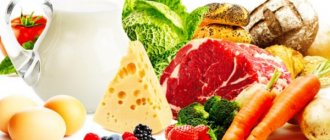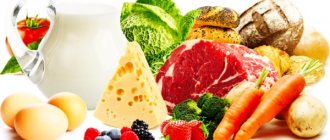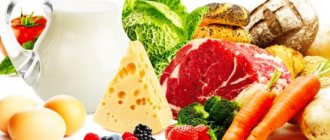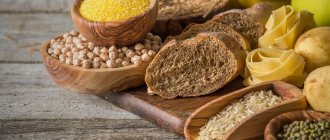“Absolutely ridiculous!” - that's what I think when reading popular nutrition books for women. It was terrible. Yogurt, cereal, coffee and a glass of juice for breakfast. Where's the protein? Sure, yogurt contains a little, but not enough to maintain the energy, satiety, and nutrition that an active woman needs. It's time to set the record straight. We need to take these old school, fairy tales about diets and throw them out! Just like we burned old bras from the 60s, let's burn old diet books, and let's go according to the program - Women need protein!
Jen Hendershott, two-time Mrs. Olympia and international fitness champion, says we need protein for muscle maintenance, energy, and even increased weight loss.
The relationship between carbohydrates and weight loss
Carbohydrates are the carrier of calories or the primary source of energy for our body.
Some of their types begin to be absorbed already in the mouth, quickly enter the circulatory system and are delivered to the cells of the muscles, brain and other organs and tissues for their nutrition.
Insulin plays an important role in the delivery of nutrients to cells - a transport hormone that is responsible for the delivery of nutrients into the cells.
— Why is it so easy to gain fat mass on carbohydrates?
The body's natural response to carbohydrates is to increase insulin levels, the purpose of which is to lower blood sugar levels.
Sugar here refers to glucose - a basic simple carbohydrate, to the level of which almost all carbohydrates break down during digestion.
When carbohydrates are eaten in quantities exceeding the body's need for energy, the excess of them, with the help of insulin, is sent for storage first to short-term energy stores - muscle and liver glycogen, and after they are filled - to long-term stores: body fat, which, as is known, can be almost dimensionless.
It turns out that the more carbohydrates in the diet, the higher the insulin level and the more favorable the conditions for fat deposition .
And vice versa: the fewer carbohydrates, the better the conditions for fat burning.
This is only one side of the coin.
Excess refined sugar in the diet leads to hormonal changes that further interfere with weight loss: in particular, the formation of immunity to leptin, a hormone that controls appetite.
This manifests itself in the fact that a person eats, but does not feel full, which means he regularly overeats. Excess calories, in turn, is the main cause of the obesity epidemic in our society, and not a lack of physical activity, as we are sometimes led to believe.
The human body has a hormonal mechanism that converts excess carbohydrates into fat; in addition, when there are a lot of simple carbohydrates in the diet, the hormonal mechanism for regulating appetite may be disrupted, which provokes overeating
We recommend : Milk: benefits and harms for the human body. Scientific facts
Key recommendations for subsidies of vitamins and microelements:
- Folic acid . To prevent the development of defects of the nervous and other systems. All women 3 months before pregnancy and the first 3 months of pregnancy at a dose of 400-800 mcg/day.
- Iodine . For married couples living in iodine-deficient areas (95% of the territory of Russia). To prevent idiopathic cretinism and congenital diseases of the thyroid gland in a child, additional iodine intake is necessary 3 months before pregnancy at a dose of 200 mcg/day, during pregnancy - 200-250 mcg/day.
- Iron . All women before and during pregnancy need iron supplementation at a dose of 60 mg/day (this dose is included in many IUDs). If anemia is present, the dose is increased as prescribed by the doctor.
- Vitamin D. It is advisable for women preparing to conceive to take vitamin D at a dose of 1000 IU/day. The decision on additional intake must be made based on determining its concentration in the blood.
- Polyunsaturated fatty acids (PUFAs). In preparation for pregnancy, it is advisable for all women to take PUFAs at a dose of 300 mg/day, followed by administration throughout pregnancy to prevent pregnancy complications and the physiological formation of the structures of the brain, visual organs and immune system of the fetus.
- Multivitamin mineral complexes . The feasibility of subsidizing vitamins and microelements in preparation for pregnancy and during pregnancy has been proven. But the decision to prescribe a specific drug is made by the doctor based on the available evidence base and confirmation of the high quality of the drug’s production.
How many carbohydrates do you need per day when losing weight?
All low-carb diets involve severely limiting the amount of carbohydrates, especially simple (sugars) and starchy (bread, potatoes, pasta).
At the same time, the ratio of protein, fat and carbohydrates for weight loss shifts towards increasing the proportion of healthy fats, protein and non-starchy vegetables rich in fiber.
According to official recommendations, the norm of carbohydrates per day for an ordinary person should be 45 - 65% of the total calorie content of food.
With an estimated calorie intake for weight loss of 2000 calories, carbohydrates account for about 225-325 grams per day.
Traditionally, a low-carb diet has been defined as a diet that consumes less than 200 grams of carbohydrates per day . However, evidence suggests that weight loss results will be significantly higher and health benefits greater if you cut back even further.
Share with us your experience of losing weight or gaining muscle mass!
Most often, the optimal norm is 50-150 grams of carbohydrates per day 1.
100-150 grams per day
The goal is to maintain weight, lean muscle mass, and lose weight.
100 - 150 g of carbohydrates per day is the recommended amount of carbohydrates per day for those who exercise and at the same time want to maintain toned lean muscle shape, or simply want to be healthy and maintain weight 2.
This amount of carbohydrates is usually sufficient for weight loss and “drying the body” in fitness/bodybuilding, but individual adjustments may be required (see below).
50-100 grams of carbohydrates per day
The goal is weight loss.
This amount is considered optimal for starting the process of systematic, sustainable weight loss 2.
For those who gain weight easily, it will also allow you to maintain weight without allowing fat deposits.
20-50 grams of carbohydrates per day
The goal is to improve health and lose weight.
This is a diet with an almost complete absence of carbohydrates, which is typical for the ketogenic diet - one of the examples of low-carbohydrate diets, which experts call one of the most effective not only for weight loss, but also beneficial for health: its list of advantages even includes an anti-cancer effect.
With such a tiny amount of carbohydrates, the metabolic health benefits begin to appear. This is an ideal diet for those who want to lose weight quickly or change the course of serious metabolic diseases , such as diabetes or cancer.
Limiting carbohydrates to 50 grams per day puts the body into ketosis, a state in which the body switches from using carbohydrates as its primary source of energy to fats 1.
The amount of carbohydrates per day when losing weight varies from 50 to 150 g per day. Below 50 g, metabolic health benefits begin to appear.
Recommended : High Intensity Interval Training: The Best Exercises to Lose Weight
The need for an individual approach to calculations
Although the exact ranges for carbohydrate norms are given above, it is necessary to understand that the optimal amount of carbohydrates for each individual person is individual and is determined at a minimum by: age, gender, body composition, level of physical activity, internal metabolic rate and, obviously, may vary significantly from person to person.
If you think what we do is important, support our project!
YES!
Athletes, especially those with high muscle mass, need more carbohydrates even at rest.
In sports, carbohydrates are the main source of energy. If they are not consumed enough, it is impossible to gain muscle mass in bodybuilding or ensure speed in running.
Moreover, muscles can even begin to break down if there is a lack of carbohydrates (=energy) in order to provide energy needs through the amino acids that make up the muscle fibers. This is the so-called “muscle catabolism”.
Taking into account the above, athletes should “limit” the amount of carbohydrates very carefully. This is why the standard ketogenic diet is NOT recommended for athletes to cut their bodies.
Internal metabolic rate is another important parameter. It is individual and is the main consumer of calories in our body: about 70% (!) of daily calories are used to ensure the functioning of internal organs and systems only.
This is a lot and explains why exercise is NOT very effective in losing weight.
The indicated value is an average and can vary quite widely from person to person.
People with fast metabolisms are called ectomorphs in body type parlance. Everyone, without exception, has met them in life: they eat a lot, but remain thin. For them, the issue of losing weight is most often irrelevant, as is the question of the need to limit carbohydrates.
The opposite body type to this is called an endomorph: the metabolic rate is low, and fat mass is gained very easily. Endomorphs need to be very careful with carbohydrates .
What's all this for?
Moreover, for people with a high metabolic rate or a high level of physical activity, more calories are required during the day, and they are provided primarily by carbohydrates.
And vice versa: for physically inactive people and those who have a low metabolic rate, carbohydrate standards for weight loss can be further reduced.
The amount of carbohydrates for weight loss is individual and determined by numerous factors, among which the level of physical activity and the rate of internal metabolism are of paramount importance.
We recommend : Cholesterol in chicken eggs: how many eggs can an adult eat per day?
Consequences of a lack of carbohydrates
With a lack of carbohydrates, the body begins to signal a malnutrition. First of all, the body begins to take energy from proteins. Because of this, they cannot perform their functions: synthesize new cells and tissues, produce antibodies and hormones.
Many diets are based on eliminating foods rich in carbohydrates. However, their absence in the body can disrupt the process of burning fat deposits, and the person, on the contrary, will gain weight.
Due to the lack of these components, a person experiences nausea, accompanied by vomiting, headaches, lethargy and fatigue.
How to calculate the individual carbohydrate norm for weight loss/"drying the body"?
The algorithm is as follows:
- Estimate your daily calorie needs using this calculator/formula;
- depending on the chosen goal (weight maintenance, weight loss, improved health), limit the amount of carbohydrates to the value indicated above;
- if within one to two months the dynamics in maintaining or reducing weight are undesirable, try reducing the amount of carbohydrates even more;
- If you lead an active lifestyle and notice a decrease in endurance, recovery rate and muscle mass, reconsider the ratio of proteins, fats and carbohydrates: increase the proportion of proteins or fats.
The correct ratio of proteins, fats and carbohydrates for weight loss
The universal rule for losing weight is as follows: what is of paramount importance is not the ratio of proteins, fats and carbohydrates, but the total calorie content of food during the day 3.4.
In order to lose weight, you need to create a calorie deficit, i.e. eat fewer calories than you burn during the day. At the same time, to maintain health, it is important to ensure the supply of necessary nutrients, the proportion of which always decreases with a decrease in calorie content (= volume of food eaten).
Read us on the networks
The ratio between proteins, fats and carbohydrates matters in the sense that some of them provide better satiety, i.e. They satisfy appetite better and are also richer in nutrients.
For example, protein foods have a high saturation index and therefore their consumption is recommended for weight loss. Digesting protein requires more energy than carbohydrates (the so-called “thermogenic effect”), which means there is less potential for fat deposition.
Also, a slight increase in protein allows you to avoid the destruction of muscle mass, which often occurs during weight loss.
It is sometimes believed that excess fat in food also promotes better satiety, but scientific research does not confirm this. We discussed this issue in an article about the effectiveness of low-carb diets for weight loss and health.
The same goes for fiber: the more foods containing it in our diet, the less we want to eat.
For weight loss, what is of paramount importance is NOT the ratio of proteins, fats and carbohydrates, but the total calorie content of food
We recommend : Which vitamins are better to take: synthetic or natural from products?
Example
The body's reaction to 100 calories of cabbage and cake differ radically.
Firstly, the serving size of cabbage with this calorie content is much larger than the size of a piece of cake, which means cabbage fills the stomach better, unlike cake, and satisfies hunger better.
Secondly, cabbage contains vitamins, minerals and fiber, which are almost completely absent in a piece of cake, which is also “loaded” with sugar and trans fats. The first is good for health, the second is harmful to it.
Thirdly, sweets cause a hormonal reaction - a sharp rise in insulin levels, and then an equally sharp decline, which causes a strong feeling of hunger and even more calorie consumption.
Fourth, excess sugar harms metabolic health, accelerates the aging process, is a factor in the development of cardiovascular diseases, leads to the formation of fatty liver, etc. etc., not to mention caries.
So, what would you prefer for lunch today: coleslaw or sweet junk?
Examples of High Protein Foods
The daily protein requirement for women determines the direction of their nutrition.
To properly organize their diet, representatives of the fairer sex should focus on dishes that include:
- Eggs. A medium-sized product contains up to 17% protein. In addition, eggs have high biological value, supplying the body with nutrients and amino acids.
- Cottage cheese. Contains up to 14% protein. The advantage of the product in question over its analogues is the fact that more time is required for the body to absorb it. This allows a woman, having consumed cottage cheese before bed, to feel full all night and not wake up from a feeling of hunger or acute discomfort in the stomach in the morning.
- Milk. It is not recommended to give preference to low-fat versions of the product, since in this case the risk of losing some of the nutritional properties of milk after a multi-stage processing system increases.
- Cheese. Despite the high protein content - up to 30%, the cheese contains a large amount of fat, which increases the calorie content of the product and creates the need to control the amount of its consumption, especially for women trying to lose weight.
- Chicken or turkey. The optimal product in terms of the ratio of protein concentration and ease of absorption of the nutrient by the body.
- Young beef. No older than 2 years. Boiled or stewed beef is considered the healthiest.
- Liver. Contains up to 25% protein, which is the maximum possible in principle. In addition, the advantages of liver include its low cost and minimal amount of calories.
- Fish of white and red varieties. It is recommended to give preference to salmon, mackerel, tuna and steam the product to preserve the maximum amount of beneficial nutrients.
How to calculate the ratio between proteins, fats and carbohydrates?
According to official recommendations, the ratio between proteins, fats and carbohydrates should be as follows:
- 20–35% of calories from fat;
- 10–35% of calories from protein;
- 45–65% of calories from carbohydrates.
When losing weight, the ratio changes: the proportion of carbohydrates decreases, and the proportions of fats and proteins increase.
How exactly? It's different on different low-carb diets.
So, on a standard ketogenic diet, which is one of the most effective for weight loss, the ratios are as follows:
- 70% of calories from healthy fats;
- 25% calories from protein;
- 5% of calories from carbohydrates.
How to use these percentages?
Nutritionists love to count everything and teach this to mere mortals, you and me. All such calculations are quite complex, unpleasant and, moreover, very inaccurate.
Remember a simple rule: the primary importance when losing weight is to reduce the amount of carbohydrates, especially simple ones (like sugar). This step alone is enough for the weight to begin to return to normal, even if you do not control the ratio between proteins, fats and carbohydrates.
Once you have determined your carbohydrate intake (see above), the remaining ingredients (protein and fats) can be varied depending on taste preferences, level of physical activity, etc.
Why taste preferences?
Because no less important than the correct quantitative ratio between proteins, fats and carbohydrates is the taste of food, or more precisely, to find for yourself a combination of macronutrients that you can stick to for a long time.
It is very important. The most effective diet is the one you can stick to for a long time.
Any calculations of the ratio between proteins, fats and carbohydrates when losing weight are very inaccurate. Limiting the amount of carbohydrates is paramount, and the proportions of protein and fat can be varied
We recommend : Is it possible to eat eggs while losing weight? Which is better: raw, boiled or fried?
Calculation example (for those who like to count)
So, let’s say the calculated calorie content of the daily diet for weight loss is 2000 calories for a man weighing 80 kg.
The selected carbohydrate norm is 150 g per day , which corresponds to maintaining weight and drying the body during sports.
150 grams of carbohydrates corresponds to 150 g * 4 calories = 600 calories (1 gram of carbohydrates = 4 calories).
Next, we calculate the amount of protein.
For physically inactive people, 0.6-1 g of protein per kilogram of body weight per day is recommended and, as noted above, this amount can be slightly increased during dieting to avoid muscle breakdown.
For calculation, we will take the lower limit of the range (0.6 g/kg) and increase it to 1 g/kg.
This corresponds to 80 kg * 1 g/kg = 80 g protein per day , which is 80 g * 4 cal = 320 calories (1 g protein has 4 calories).
And finally, fats. We subtract the proportion of calories from proteins and carbohydrates from the total calorie content to determine the calorie content of fat: (2000 cal - 600 cal - 320 cal) = 1080 cal. That's 1080 cal/9 cal = 120 grams of fat per day (1 gram of fat has 9 calories).
Why is lack of protein in the diet bad?
Unfortunately, protein is a nutrient that is often underestimated when it comes to women's diets. In some ways, many people believe that women do not need to emphasize protein in their diet, but it is necessary.
Protein is made up of amino acids, the building blocks of many tissues in our body, including muscles. Some amino acids are essential, meaning the body cannot produce them, so they must be obtained from food.
When you exercise, you break down muscle tissue. In order to repair this muscle tissue, build muscle and become stronger, you need to give your body protein to replace the amino acids needed for recovery. If you don't get enough protein in your diet, your body doesn't have enough amino acids, especially important amino acids, to function properly and recover after exercise.
Where do you get these missing amino acids?
That's right, from muscle tissue! All the hard work will be in vain! Additionally, besides needing protein for post-workout recovery, protein and amino acids are important for many other reasons:
- Maintaining immune system function
- Maintains healthy connective tissue, hair, nails and other tissues
- Maintaining Energy Levels
Now we know why protein is so important, let's determine how much protein a woman needs.
What are the best carbohydrates for weight loss?
According to the generally accepted classification, carbohydrates can be divided into simple and complex (or fast and slow).
This division is quite arbitrary, since there are no products that contain exclusively simple or complex carbohydrates, but it is quite suitable for ease of understanding the issue.
All simple or fast carbohydrates are the worst carbohydrates for weight loss and health. You should avoid consuming them in large quantities, as well as refined foods with a high content of them.
What are we talking about?
The list of fast carbohydrates harmful for weight loss includes:
- table sugar (sucrose);
- Brown sugar;
- cane sugar;
- corn syrup;
- glucose;
- fructose or fruit sugar;
- lactose or milk sugar;
- maltose or malt sugar.
We recommend : The harm of sugar to the human body. Scientific research
List of foods containing “fast” carbohydrates that are harmful for weight loss:
- sugar
- honey, jams, syrups
- sweet carbonated drinks
- sports drinks
- candies, chocolate
- Dessert
- ice cream and milkshakes;
- breakfast cereals.
We recommend : Fructose instead of sugar: benefits and harm. Scientific research
List of recommended foods containing proteins, fats and “complex” carbohydrates that are useful for weight loss:
- raw nuts (almonds, cashews, hazelnuts, brazil);
- seeds (sesame, pumpkin seeds, cumin, hemp, flax);
- legumes (lentils, beans, mung beans, chickpeas, peas);
- non-starchy vegetables (cabbage, broccoli, tomatoes, onions, eggplant, cucumbers, peppers, spinach, etc.);
- avocado;
- grains (buckwheat, brown rice, oatmeal, millet, wholemeal bread);
- lean white meat (chicken, turkey);
- fish and other seafood rich in omega-3 fatty acids (salmon, sardines, anchovies and krill);
- oils: coconut oil, butter, cocoa butter, olives and olive oil (check that the olive oil has not been diluted with cheap vegetable oils);
- organic pasteurized eggs.
For more detailed information about the types of carbohydrates, which ones are more and less beneficial for weight loss, read What foods contain carbohydrates and which ones are the best for weight loss and health?, and What NOT to eat and what you SHOULD eat to lose weight ?
Basic principles of nutrition for pregnant women:
- Full satisfaction of the physiological needs of pregnant women for nutrients and energy, without exceeding them.
- Maximum dietary diversity including all food groups.
- Providing additional intake of protein, calcium and iron, and dietary fiber in the 2nd half of pregnancy.
- Additional intake of vitamin and mineral preparations.
- Limiting the consumption of salt, salty foods, saturated fats, simple carbohydrates.
- Limiting the consumption of foods with a high allergenic potential, as well as foods rich in essential oils, spices, and herbs.
- Exclusion of alcoholic beverages, coffee, carbonated drinks.
- The menu of pregnant women should include traditional foods, seasonal vegetables and fruits.
Application of the principles of rational nutrition for pregnant and lactating women allows for optimal pregnancy, the birth of a healthy child and a sufficient duration of breastfeeding.











